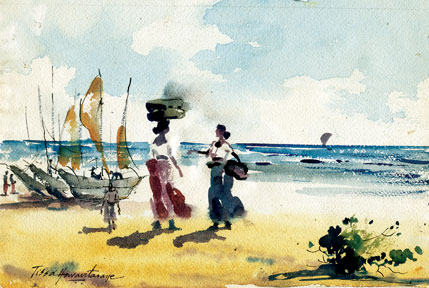Banishing false fears of water colourists
by Tissa Hewavitharane
Over the years a false mystique has been built around the subject of
water-colour painting and the practice has seemed to be weighed down by
rigid rules, dogma and ritual. This has had the effect of scaring would
-be water colourists and filling them with inhibitions that some never
get around. I hope to sweep aside the cobwebs and let some air into the
subject and give a taste of excitement to the medium you have cast aside
once.
 The techniques in water-colour painting are based largely on common
sense. The techniques in water-colour painting are based largely on common
sense.
Fears
Let's start with the fears. They say it's so much more difficult than
oil painting because you can not alter anything. Once you've put it
down. This is a false idea. There are many ways of altering whole areas
of the painting without harming the paper surface. There's the fear of
spoiling that virgin sheet of paper you've paid for. The fear of
actually starting, any excuse will do. It is really, a fear of failing.
There's the fear of wasting paint. A terrible meanness seems to come
over some people when they get a small tube of expensive paint in their
hands. A minute quantity goes on the palette and the top is then hastily
screwed on again.
These fears all show in the tightness of a beginner's work as he
edges forward inch by inch, reluctant to make a bold statement. He has
the fear of making mistakes by putting too much paint on at once.
The end result is often giving excessive attention to details, weak,
muddy, over-elaborate painting which is the last thing he really wants.
Faults
Now let's look at the main faults of water colourists. First is
fiddling, that dreadful urge to over-elaborate long after you should
have finished. The other main fault is using too much water and not
enough paint. This is reluctance to commit oneself to put in the really
strong darks where necessary which usually makes the finished picture
look as if it has a sheet of tissue paper over it.
One of the other hazards of would be water colourists is the
materials. I find so many painters unknowingly do not give themselves a
chance from the beginning. They struggle with old paint boxes, rows of
little hard paints which require scrubbing to get any paint off at all,
and with no possibility of producing rich washes. They often start with
too many colours, in the hope of having a ready-made colour for every
occasion, and finish up being thoroughly confused as to which of their
four blues they should use for the sky.
Also the brushes range in sizes from 00 to 4 which, in the main, are
far too small to produce large, fresh washes, and present an absolute
invitation to fiddle. Pallettes are also usually too small and pokey
with no room to mix enough paint for large areas.
Paper
Finally, there's the paper. This is often too thin and cockles badly
when wet, unless it's stretched on a board. A beginner might say, "I've
been painting in water-colours for some years but my work is too tight.
I'd love to paint in a loose, fresh way but something always prevents
me."This is very often due to complication and over work. To me there
are two words which are all important when producing a water-colour.
They are simplicity and purity.
Simplicity is putting on paints directly and decisively, then leaving
the stuff alone. Often it is the most difficult thing to do as there's
temptation to go on poking at it.
Purity is the transparency you must try to keep, not just in a light
sky, but in your strong darks. One can get this by using rich colour put
in first time and not by painting it on in weak muddy layers.
Watercolour is rather like golf, the fewer strokes you use the more
professional it looks. Remember in water-colour confidence is essential
and that is brought by being in complete control of your tools and
techniques.
No one can write a beautiful poem without acquiring a proper
vocabulary. Many painters try to paint their own way. If you are
painting fresh watercolour to your entire satisfaction don't change.
When you are painting in water colour one of the main qualities you need
is courage.
Remember it is only a sheet of paper. If you're going to fail let it
be a really glorious failure rather than a weak miserable one. Don't be
scared, have a go. You could learn very fast once you have taken the
plunge and you may never have to make excuses again about the quality of
your painting.
|



